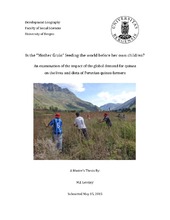| dc.description.abstract | This project examines factors the impact of the increasing global demand for quinoa (Chenopodium quinoa) on its production and local consumption in southern Peru through a methodological triangulation of semi-structured interviews, external data from national monitoring sources, and secondary sources collected from other researchers. This paper presents data collected through semi-structured interviews with 50 participants from 12 villages in the vicinity of Puno and Cuzco. Fieldwork took place from May to July 2014 and interviews were made possible with the help of key informants and interpreters. This paper examines how the social, political, and economic value of quinoa has changed as the result of increased global demand and how those changes have affected local quinoa consumption among southern Peruvian quinoa farmers. The escalating monetary value of quinoa has induced farmers to produce more both for themselves and for the market, although they have yet to see significant financial gains. The social value of quinoa, inflated by vociferous promotion from Peruvian First Lady Nadine Heredia and the Food and Agriculture Organization of the United Nations (FAO), has resulted in increased consumption among more financially stable farmers, whereas poorer farmers lack the resources to produce more. This study concentrates on the microlevel concerns of individuals and households associated with the commercialization and global demand for quinoa, a traditional food crop that has fluctuated in value due to external pressures that once discouraged but now encourage its local consumption. Although this study did not find evidence of dietary transition among the southern Peruvian informants, it was found that quinoa's social significance is increasing along with the global demand, thus leading the way for increased local consumption and production of quinoa. | en_US |
